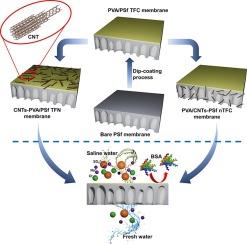Decoration of carbon nanotubes in the substrate or selective layer of polyvinyl alcohol/polysulfone thin-film composite membrane for nanofiltration applications
IF 2.5
Q2 CHEMISTRY, MULTIDISCIPLINARY
引用次数: 0
Abstract
Nanofiltration (NF) membranes demonstrate considerable promise for desalinating saline water and wastewater containing mineral salts to overcome the lack of fresh water and improve drinking water quality. This research work aims to detect the influence of carbon nanotubes (CNTs) on the filtration performance of polyvinyl alcohol (PVA)/polysulfone (PSf) thin-film composite NF membranes. For this purpose, CNTs were incorporated in the PSf substrate/PVA selective layer to fabricate a thin-film composite (TFC) with nanocomposite substrate (nTFC) and a thin-film nanocomposite (TFN) membranes, respectively. To fabricate TFC membranes, PSf substrates with different concentrations (16–20 wt%) were made using the phase inversion technique. Then, the selective layer of PVA was formed on the PSf support through cross-linking with glutaraldehyde during dip-coating. The membranes’ NF performance was assessed by filtration of NaCl and Na2SO4 solutions at a relatively low pressure of 0.3 MPa. The salt rejection of all prepared membranes followed the sequence of Na2SO4 > NaCl, indicating the characteristics of negatively charged membranes. By embedment of 0.05 wt% CNT in the PSf substrate/PVA selective layer, the rejections of over 43% for NaCl and over 80% for Na2SO4 were obtained, which is higher than that of TFC-16 as a control membrane (18.1% for NaCl and 74.7% for Na2SO4). Furthermore, in the presence of CNTs, the permeance and fouling resistance of the nTFC and TFN membranes have been improved compared to the TFC-16 membrane.

在基材或聚乙烯醇/聚砜薄膜复合膜的选择层上装饰碳纳米管,用于纳滤应用
纳滤(NF)膜在淡化咸水和含矿物盐的废水以克服淡水缺乏和改善饮用水质量方面显示出相当大的前景。本研究旨在检测碳纳米管(CNTs)对聚乙烯醇(PVA)/聚砜(PSf)薄膜复合滤膜过滤性能的影响。为此,在PSf衬底/PVA选择层中掺入CNTs,分别制备了具有纳米复合衬底(nTFC)和薄膜纳米复合膜(TFN)的薄膜复合材料(TFC)。为了制备TFC膜,采用相转化技术制备了不同浓度(16-20 wt%)的PSf底物。然后,在浸涂过程中与戊二醛交联,在PSf载体上形成PVA选择性层。在相对较低的压力(0.3 MPa)下对NaCl和Na2SO4溶液进行过滤,评价膜的滤膜性能。各制备膜的脱盐性能依次为Na2SO4 >;NaCl,表明带负电膜的特性。在PSf底物/PVA选择层中嵌入0.05 wt%的碳纳米管,NaCl的去除率超过43%,Na2SO4的去除率超过80%,高于对照膜TFC-16 (NaCl的去除率18.1%,Na2SO4的去除率74.7%)。此外,在CNTs的存在下,与TFC-16膜相比,nTFC和TFN膜的渗透性和耐污性都得到了提高。
本文章由计算机程序翻译,如有差异,请以英文原文为准。
求助全文
约1分钟内获得全文
求助全文

 求助内容:
求助内容: 应助结果提醒方式:
应助结果提醒方式:


